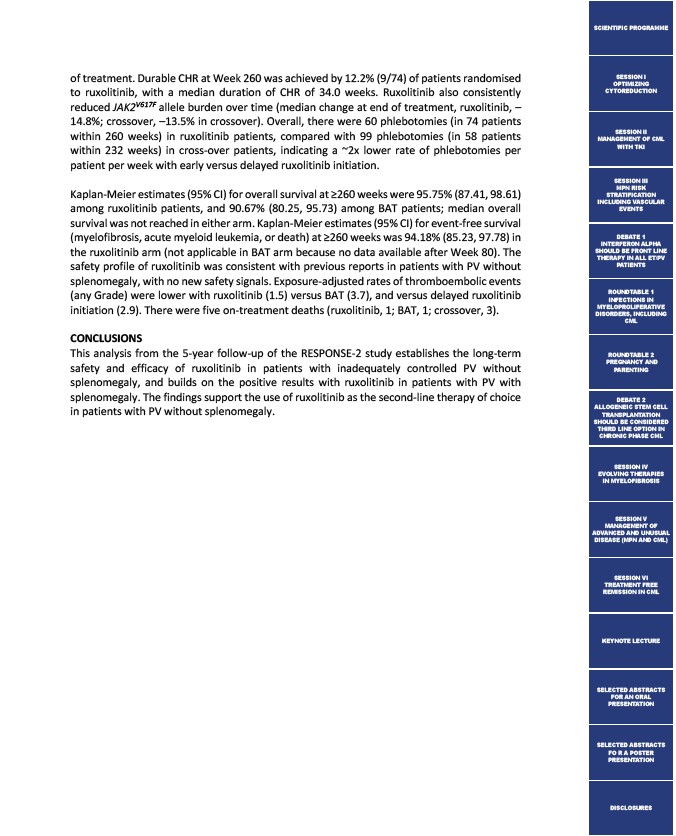
of treatment. Durable CHR at Week 260 was achieved by 12.2% (9/74) of patients randomised
to ruxolitinib, with a median duration of CHR of 34.0 weeks. Ruxolitinib also consistently
reduced JAK2V617F allele burden over time (median change at end of treatment, ruxolitinib, –
14.8%; crossover, –13.5% in crossover). Overall, there were 60 phlebotomies (in 74 patients
within 260 weeks) in ruxolitinib patients, compared with 99 phlebotomies (in 58 patients
within 232 weeks) in cross-over patients, indicating a ~2x lower rate of phlebotomies per
patient per week with early versus delayed ruxolitinib initiation.
Kaplan-Meier estimates (95% CI) for overall survival at ≥260 weeks were 95.75% (87.41, 98.61)
among ruxolitinib patients, and 90.67% (80.25, 95.73) among BAT patients; median overall
survival was not reached in either arm. Kaplan-Meier estimates (95% CI) for event-free survival
(myelofibrosis, acute myeloid leukemia, or death) at ≥260 weeks was 94.18% (85.23, 97.78) in
the ruxolitinib arm (not applicable in BAT arm because no data available after Week 80). The
safety profile of ruxolitinib was consistent with previous reports in patients with PV without
splenomegaly, with no new safety signals. Exposure-adjusted rates of thromboembolic events
(any Grade) were lower with ruxolitinib (1.5) versus BAT (3.7), and versus delayed ruxolitinib
initiation (2.9). There were five on-treatment deaths (ruxolitinib, 1; BAT, 1; crossover, 3).
CONCLUSIONS
This analysis from the 5-year follow-up of the RESPONSE-2 study establishes the long-term
safety and efficacy of ruxolitinib in patients with inadequately controlled PV without
splenomegaly, and builds on the positive results with ruxolitinib in patients with PV with
splenomegaly. The findings support the use of ruxolitinib as the second-line therapy of choice
in patients with PV without splenomegaly.
SCIENTIFIC PROGRAMME
SESSION I
OPTIMIZING
CYTOREDUCTION
SESSION II
MANAGEMENT OF CML
WITH TKI
SESSION III
MPN RISK
STRATIFICATION
INCLUDING VASCULAR
EVENTS
DEBATE 1
INTERFERON ALPHA
SHOULD BE FRONT LINE
THERAPY IN ALL ET/PV
PATIENTS
ROUNDTABLE 1
INFECTIONS IN
MYELOPROLIFERATIVE
DISORDERS, INCLUDING
CML
ROUNDTABLE 2
PREGNANCY AND
PARENTING
DEBATE 2
ALLOGENEIC STEM CELL
TRANSPLANTATION
SHOULD BE CONSIDERED
THIRD LINE OPTION IN
CHRONIC PHASE CML
SESSION IV
EVOLVING THERAPIES
IN MYELOFIBROSIS
SESSION V
MANAGEMENT OF
ADVANCED AND UNUSUAL
DISEASE (MPN AND CML)
SESSION VI
TREATMENT FREE
REMISSION IN CML
KEYNOTE LECTURE
SELECTED ABSTRACTS
FOR AN ORAL
PRESENTATION
SELECTED ABSTRACTS
FO R A POSTER
PRESENTATION
DISCLOSURES